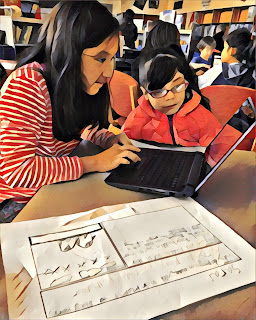Public education is one of America’s greatest masterpieces. Getting
students to graduation is not enough. Educators and communities are committed
to ensuring students are “ready” for future learning, work, and civic
engagement after high school. But
what does “ready” mean?
Unfortunately, standardized test scores have been predominantly used
as the way to determine if someone is “ready” to graduate, and those alone do
not provide an accurate or comprehensive picture of our students’ potential. Students
(or educators) should never be defined by a single test score.
Our students are more than a score!
Dr. David Schuler - Superintendent of Township
High School District 214, past AASA President, and current National
Superintendent of the Year - led an effort to identify multiple measures based
on research to more appropriately assess that students are college-ready,
career-ready, and life-ready. This work has become AASA’s national initiative
called Redefining Ready! Using these indicators, we can paint a more
realistic portrait of a graduate so that students and families can see what it
looks like to be “ready” for future success.
College Ready Indicators
Students are College Ready if they meet either the academic indicators or standardized
testing benchmarks listed below.
GPA 2.8 out of 4.0 and one or more of the following academic indicators:
·
Advanced Placement Exam (3+)
·
Advanced Placement Course (A, B or C)
·
Dual Credit College English and/or Math (A, B or C)
·
College Developmental/Remedial English and/or Math (A, B
or C)
·
Algebra II (A, B or C)
·
International Baccalaureate Exam (4+)
·
Standardized Testing Benchmarks (minimum score)
SAT Exam: Math (530) | Reading and Writing (480)
ACT Exam: English (18) | Reading (22) | Science (23) |
Math (22)
College Readiness Placement Assessment
Additional Factors that Contribute to College Success
Earning As, Bs, Cs; FAFSA completion; enrollment in career pathway course
sequence; college academic advising; participation in college bound bridge
programs; senior year math class; completion of a math class after Algebra II.
Career Ready Indicators
Students are Career Ready if they have identified a career interest and
meet two of the behavioral and experiential benchmarks listed below. In
addition, students entering the military upon graduation must meet the passing
scores on the Armed Services Vocational Aptitude Battery (ASVAB) for each
branch
of the military.
Career Cluster Identified and two or more of the following benchmarks:
·
90% Attendance
·
25 hours of Community Service
·
Workplace Learning Experience
·
Industry Credential
·
Dual Credit Career Pathway Course
·
Two or more organized Co-Curricular Activities
Life Ready
Being Life
Ready means students leave high school with the grit and perseverance to tackle
and achieve their goals. Students who are Life Ready possess the growth mindset
that empowers them to approach their future with confidence, to dream big and
to achieve big. Our nation’s schools provide social and emotional support and
experiences to equip students with the life skills they will need for success
in their future.
While little
research exists in the Life Ready realm, AASA and the Redefining Ready!
campaign are currently studying how to best measure these life ready
skills.
Meanwhile, some school districts have worked
with their staff and community to identify Life Ready indicators that represent
their local values and aspirations for students. For example, the Orting School
District’s Life Ready menu includes 25 hours of community service, character education
focusing on servant leadership, and digital citizenship and technology literacy.
Once the Orting School District defined what
“ready” for college, careers, and life meant for students, the system was
poised to support it in intentional ways. This was not yet another initiative;
it became the anchor that connected the district’s work. It brought system
focus and coherence. Course planning and catalogs were connected to college,
career, and life readiness. Every school’s annual improvement plan goals were explicitly
connected to it, and resources were aligned to support it. For example, they
redefined multi-tiered systems of support (MTSS) to remove barriers to being
college-ready (academics), career-ready (attendance), and life-ready
(behavior). Having set this clear direction for the system, the School Board could
more accurately and comprehensively monitor progress around readiness using
data. Board meeting time focused on the core mission of all students “ready.” Meeting
agenda items and reports were coded to it, and academic and operational plans
were anchored to it. “When I see Orting graduates walking across the stage with
their College, Careers, and Life honor cord,” said Superintendent Shepard, “I
know they have the skills, dispositions, and tangible plans to dream and
achieve big.”
Dr. Schuler said, “If students can’t see it, they
can’t dream it.”
Now that our students, families, staff, and
community can have a clear picture of what “ready” for college, careers, and
life looks like, we can help make dreams come true!
Dr. Marci Shepard
Superintendent
Orting School District








